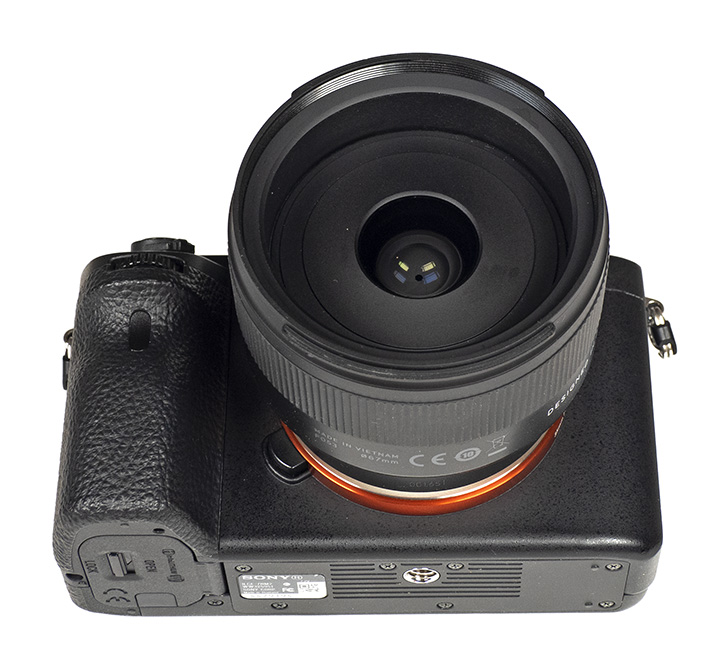|
Tamron 35mm f/2.8 Di III OSD M1:2 - Lab Test / Review |
|
Lens Reviews -
Sony Alpha (Full Format)
|
|
Page 1 of 2
Review by Klaus Schroiff, published July 2021

Introduction
It seems that comparatively slow-speed "budget" prime lenses are all the rage these days. A few years ago, Samyang was probably the one starting the segment with a number of affordable (semi-)pancake lenses. This was followed by Sigma with a more premium approach. In late 2019, Tamron entered the scene with three identical-looking primes - a 20mm f/2.8, 24mm f/2.8, and a 35mm f/2.8. Traditionally, Tamron is more of a mid-tier player but the gang of 3 is clearly budget-oriented. We'll review them all in the next few weeks and let's start with the Tamron 35mm f/2.8 Di III OSD M1:2, thus a moderate wide-angle. It's available for as little as 250 USD/EUR.
 For this amount of money, you can't expect professional-grade quality. The chassis is made of average quality plastics based on a metal mount. The rubberized focus ring operates smoothly albeit it doesn't scream premium. Surprisingly, the lens has some seals making it moisture resistant albeit there isn't a word about dust protection. While the length of the lens doesn't change during focusing, there's a moving inner lens tube. It isn't fully clear why Tamron designed the lens to be relatively long because this tube is quite deeply recessed by about 1.5cm. Instead, they could have made the lens shorter at the expense of having a protruding inner tube at certain focus distances. Rather than providing a conventional lens hood, Tamron went to a flat-faced "windowed" version. While we like this conceptually, it is worth noting that the hood (made in the Philippines) feels even cheaper than the lens (made in Vietnam).
For this amount of money, you can't expect professional-grade quality. The chassis is made of average quality plastics based on a metal mount. The rubberized focus ring operates smoothly albeit it doesn't scream premium. Surprisingly, the lens has some seals making it moisture resistant albeit there isn't a word about dust protection. While the length of the lens doesn't change during focusing, there's a moving inner lens tube. It isn't fully clear why Tamron designed the lens to be relatively long because this tube is quite deeply recessed by about 1.5cm. Instead, they could have made the lens shorter at the expense of having a protruding inner tube at certain focus distances. Rather than providing a conventional lens hood, Tamron went to a flat-faced "windowed" version. While we like this conceptually, it is worth noting that the hood (made in the Philippines) feels even cheaper than the lens (made in Vietnam).

 The AF system uses a linear extension system. Typical for this focusing type, the AF speed is on the slow side but it's at least noiseless. The same can't be said about the aperture mechanism. When stopped down, you can hear that the camera is opening/closing the aperture during focusing operations. Once again, this has a cheap feel to it. As usual, manual focusing works "by-wire". The precision is pretty good in this case. A specialty of the lens is its close-focusing capability. It can focus down to a max object magnification of 1:2 (hence the M1:2 in the lens name). An image stabilizer has not been implemented which is hardly surprising given the price point.
The AF system uses a linear extension system. Typical for this focusing type, the AF speed is on the slow side but it's at least noiseless. The same can't be said about the aperture mechanism. When stopped down, you can hear that the camera is opening/closing the aperture during focusing operations. Once again, this has a cheap feel to it. As usual, manual focusing works "by-wire". The precision is pretty good in this case. A specialty of the lens is its close-focusing capability. It can focus down to a max object magnification of 1:2 (hence the M1:2 in the lens name). An image stabilizer has not been implemented which is hardly surprising given the price point.

| Specifications |
|---|
| Optical construction | 9 elements in 8 groups inc. 1x aspherical and 1x LD element |
| Number of aperture blades | 7 (rounded) |
| min. focus distance | 0.15m (max. magnification 1:2) |
| Dimensions | 64x73mmm |
| Weight | 210g |
| Filter size | 67mm |
| Hood | barrel-shaped with frame window (bayonet mount, supplied) |
| Other features | dust & moisture resistant |
| Mount | Sony FE |
|